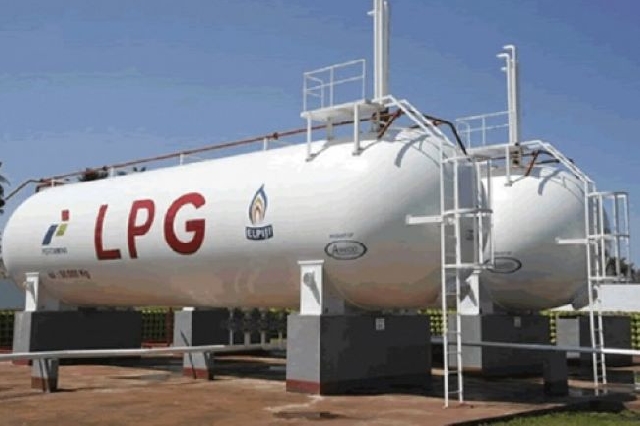Cedi fall may spark LPG, gasoline price hike
 LPG
LPG
The Institute for Energy Security (IES) has projected some stability in the current price of gasoil in spite of the 8.41% fall in the price of the product on the international market, as a result of the 4.26% decline in the value of the local currency, Ghana cedi, against the US dollar.
The cedi depreciation of 4.26% is enough to force prices of gasoline and LPG to move upward in “significant terms, irrespective of the marginal drop (1.59%) and the marginal increase (0.59%) in the price of Gasoline and LPG on the world fuel market”, the IES said in a statement produced in full below:
CEDI DEPRECIATION MAY CAUSE AN INCREASE IN LPG AND GASOLINE PRICES FOR FIRST HALF OF OCTOBER
REVIEW OF SEPTEMBER 2022 SECOND PRICING-WINDOW
Local Fuel Market Performance
Gasoline sold lower in the last pricing window across majority of the Oil Marketing Companies (OMCs) monitored by the Institute for Energy Security (IES), with Gasoil price remaining unchanged. The national average price per litre of Gasoline now stands at GH¢10.90 down from GH¢11.30 in the last window, representing a 3.54% decrease. Gasoil’s national average price per litre remains unchanged at GH¢14.45 as OMCs maintained their prices.
The IES Marketscan picked Total, Sel, GOIL and Shell/Vivo as OMCs with the highest-priced fuel on the downstream petroleum market. Benab Oil, Zen Petroleum, Goodness Oil, Allied and Petrosol were spotted as the OMCs with the least-priced fuel on the local fuel market.
World Oil Market
The International Benchmark saw a 5.11% price reduction over the previous pricing window’s average price to a current average price of $89.47 per barrel.
Global oil prices continue to trend downwards, largely on fears of a recessions despite repeated claims of an undersupply set to hit the market. Oil traders and investors still see the bigger threat of a recession as a more viable reason in the short-term to price oil below rates seen in weeks past.
IES Construct, with data from Oilprice.com
Despite the undersupply sentiments not affecting current prices, analysts see a worst-case scenario with oil prices soaring even when we enter the recession period as the years of underinvestment in oil fields production will be the major catalyst for escalating prices.
Some analysts predict prices rising to above $100 per barrel above the current prices that have trended below $90 per barrel in the just ended pricing window.
Oil demand in this year has remained fairly resilient in the face of a multitude of challenges, and even prices of over $100 per barrel failed to curb demand in any significant way earlier this year. Now, prices seem to be somewhat tempered as we continue to experience consecutive windows of drops from its highs above $100 per barrel to lows close to $80 per barrel, a reduction of close to $20 per barrel.
With the Russian oil and gas embargo set to kick in fully in December, prices are bound to jump because alternative supply is limited, as has been evidenced in OPEC’s consistent failure to meet its set production targets within the course of the year. With further OPEC production cuts set to be put in motion as the weeks run by and the need for the U.S. to start refilling its strategic petroleum reserve (SPR) in order to avoid depletion, oil prices point to an upward trend by the close of the year, returns to highs seen at the end of the Q1 of this year.
World Fuel Market
The world fuel market saw price changes as monitored on Standard & Poor's (S&P's) Platts platform within the just-ended pricing window. Gasoline price fell by a marginal 1.59%, from its initial price of $847.11 per metric tonne to the end date price of $833.68 per metric tonne. Gasoil price however saw a sharp decline of 8.41% from its earlier price of $1092.92 per metric tonne to a present price of $1001.05 per metric tonne. Liquefied petroleum gas (LPG) price on the international market increased marginally by 0.79% from $590.97 per metric tonne in the last pricing window to an end date price of $595.65 per metric tonne.
Local Forex Market
Data monitored by the IES Economic Desk from the foreign exchange (Forex) market points to a further depreciation of the Cedi against the US Dollar. The Ghana Cedi depreciated by 4.26% from the previous rate of GH¢10.10 to the current rate of GH¢10.53 to the US dollar.
IES PROJECTIONS FOR OCTOBER 2022 FIRST PRICING-WINDOW
The Institute for Energy Security (IES) projects some stability in the current price of Gasoil in spite of the 8.41% fall in the price of the product on the international market, as a result of the 4.26% decline in the value of the local currency against the US Dollar.
The Cedi depreciation of 4.26% is enough to force prices of Gasoline and LPG to move upward in significant terms, irrespective of the marginal drop (1.59%) and the marginal increase (0.59%) in the price of Gasoline and LPG on the world fuel market.
Signed:
Fritz Moses
Research Analyst, IES ([email protected])
Source: Classfmonline.com
Trending News

Health Minister receives report on Zipline Medical Drone Service
16:59
No apology, but diplomacy: Israel pushes back on Ghana claim
20:43
3 candidates in the race as EC schedules Kpandai rerun for Dec 30
19:57
Adu-Boahene case: Atta Akyea exposes inconsistencies in A-G witness’s EOCO testimony
06:45
Amasaman MP marks one-year anniversary of election victory, pledges accelerated development
06:46
NDC Legal Director thanks God for party’s election victory
03:36
Majority Leader withdraws Special Prosecutor repeal Bill after President Mahama’s appeal
16:34
VP Opoku-Agyemang eyes English-teaching opportunities in Colombia as language, cultural ties grow
11:26
Ghana deports 3 Israelis in retaliation, gov'ts commit to resolution
19:29
CID, BoG arrest 41 in Accra crackdown on illegal forex trading
22:25




